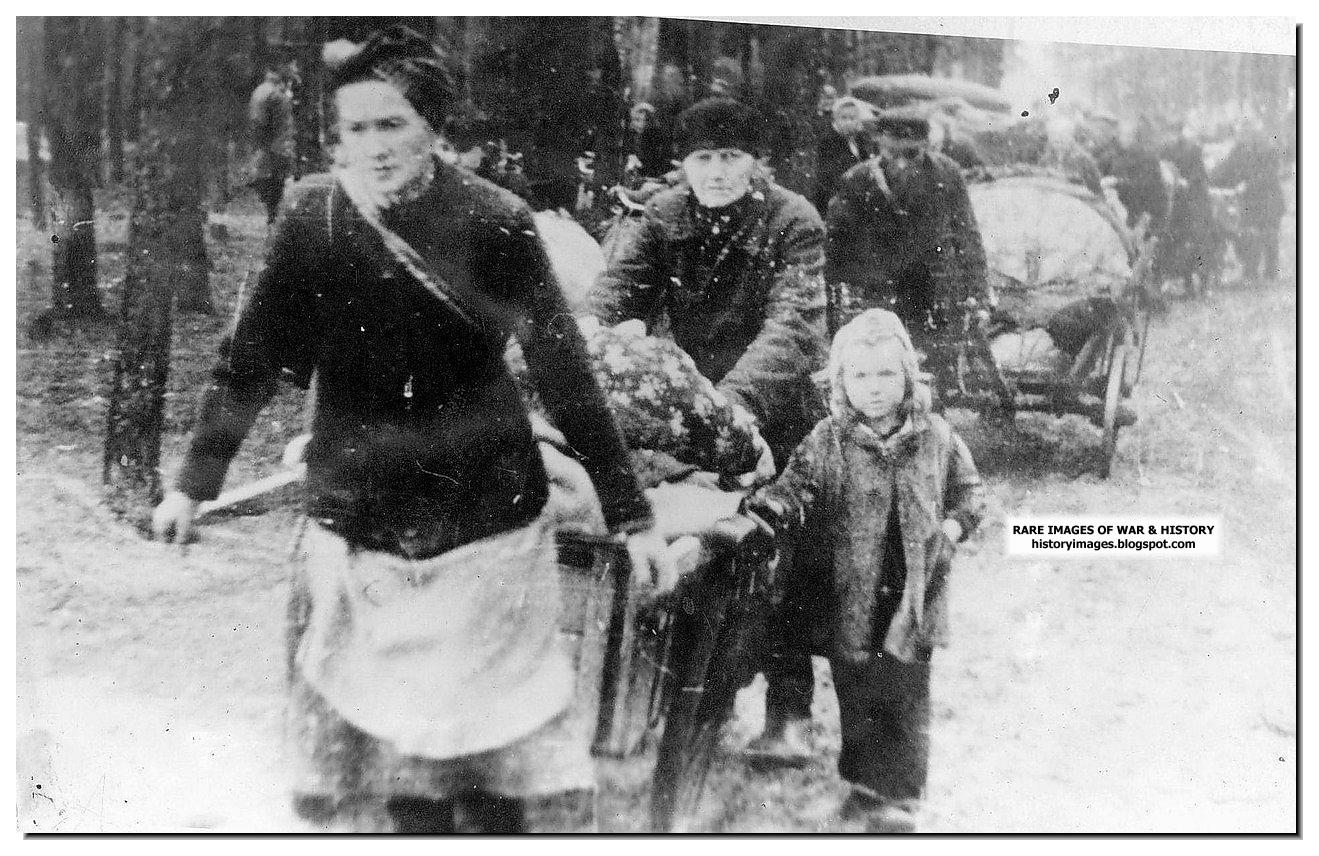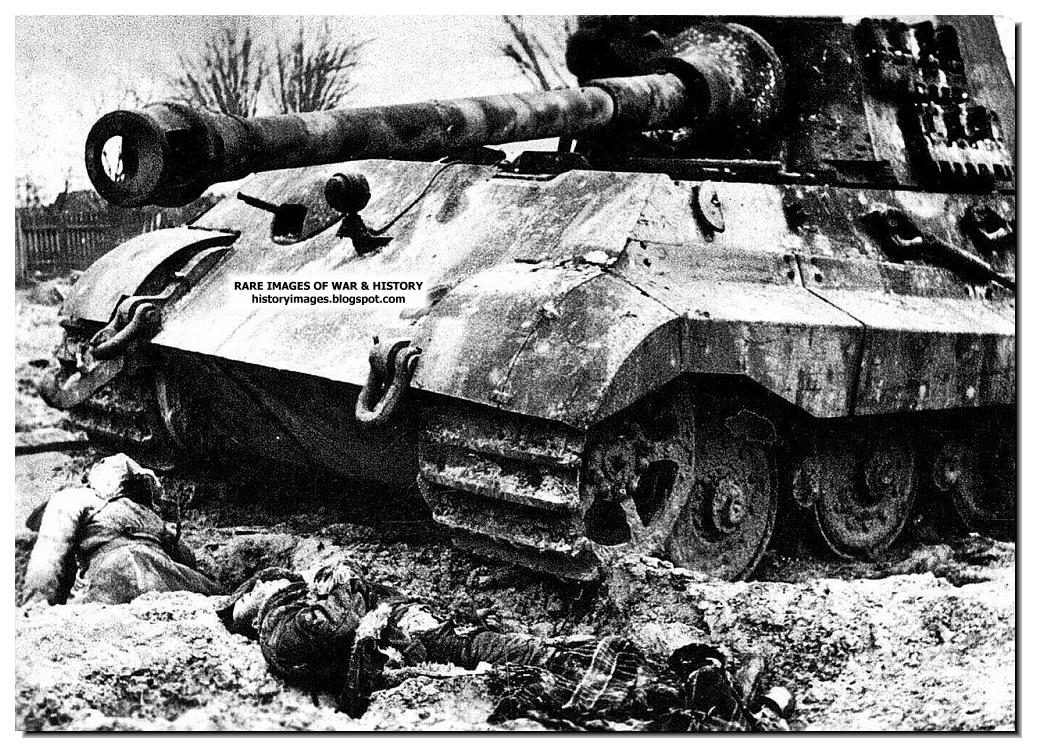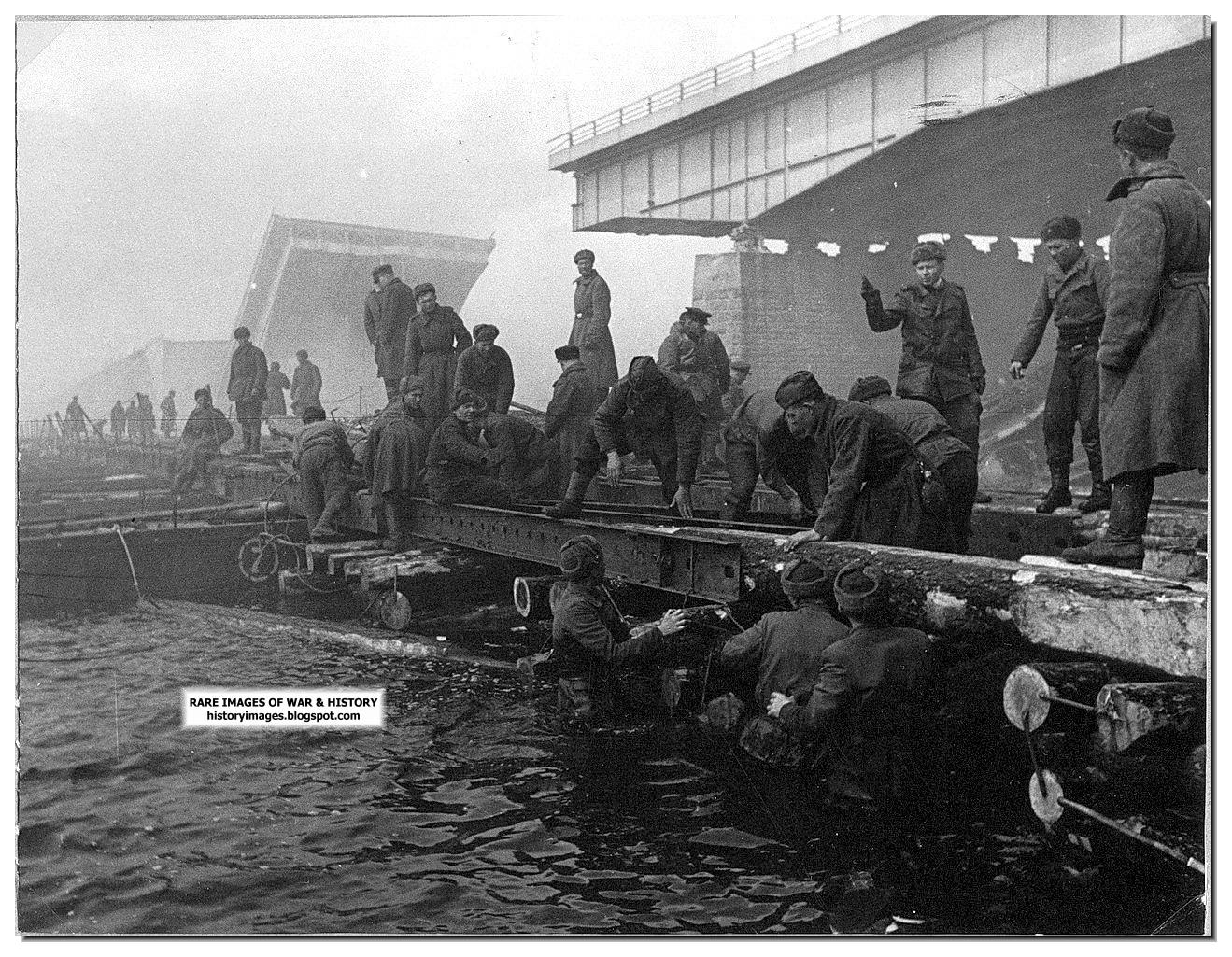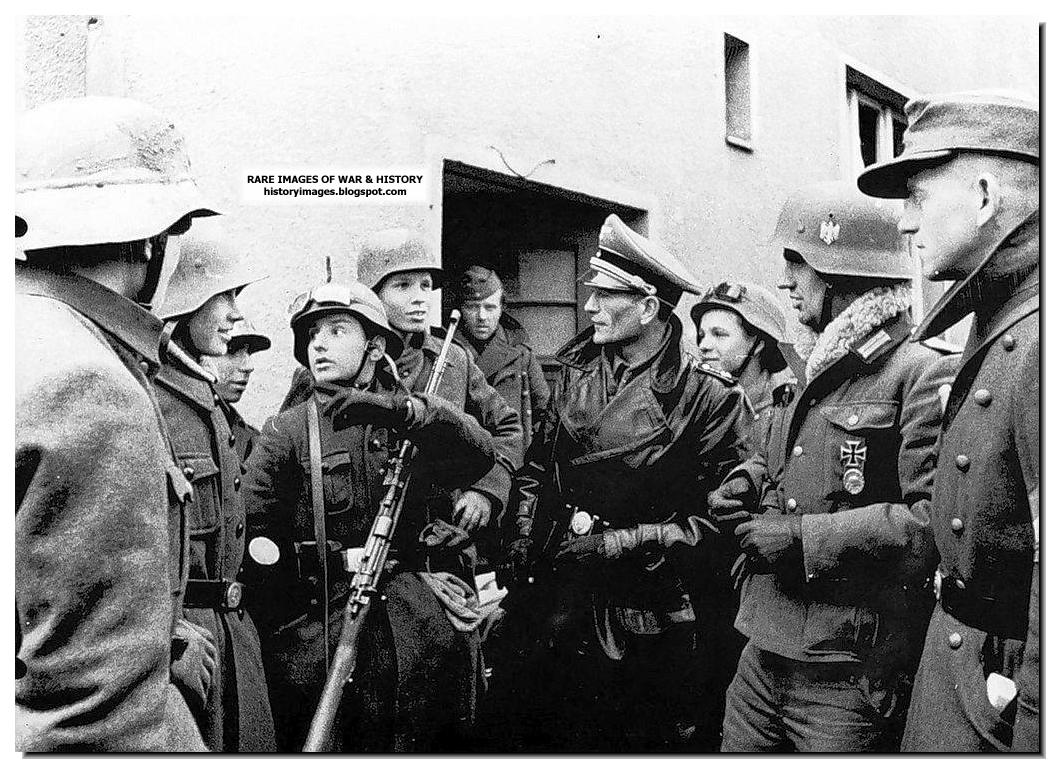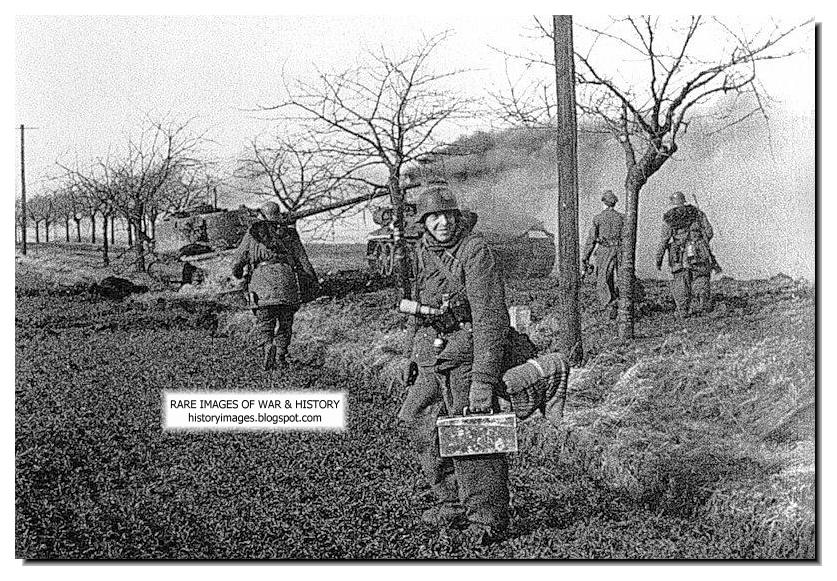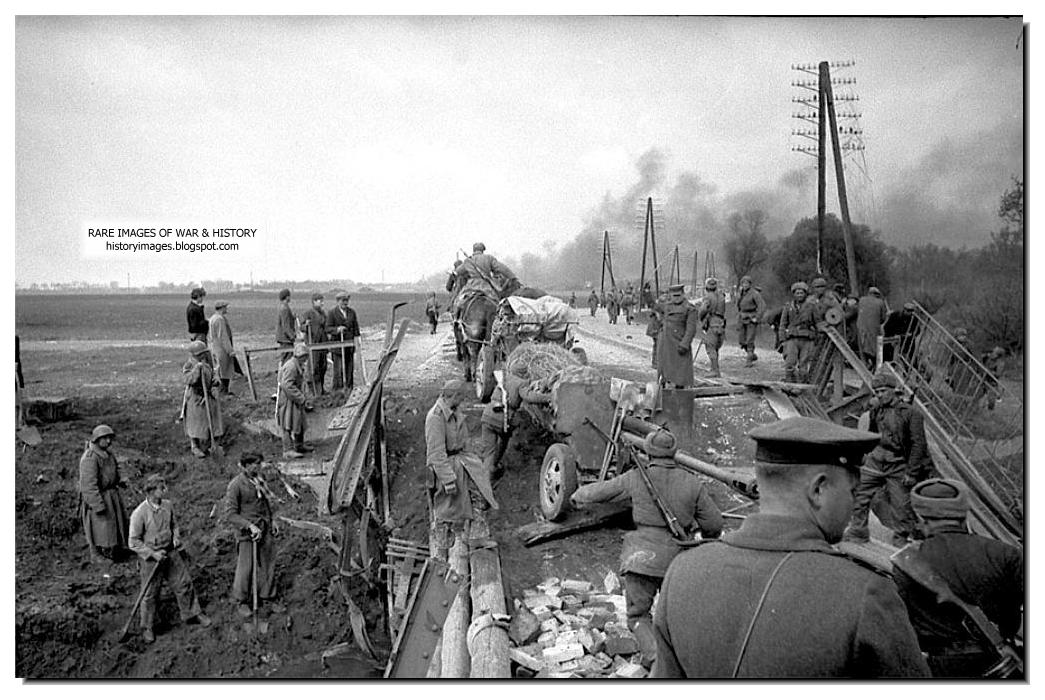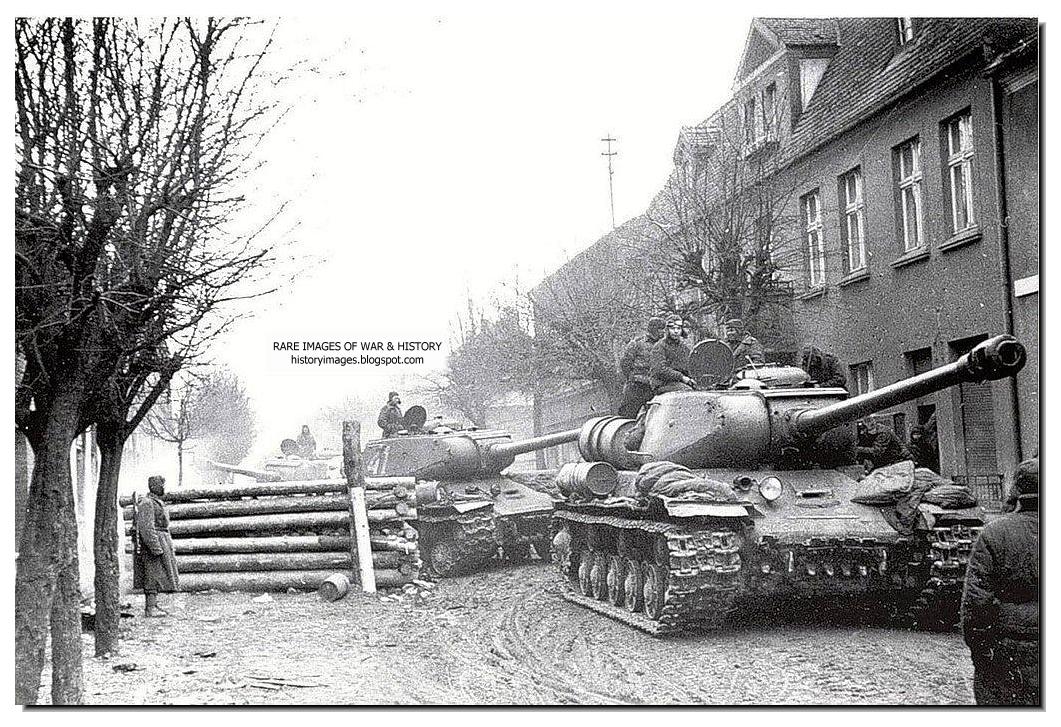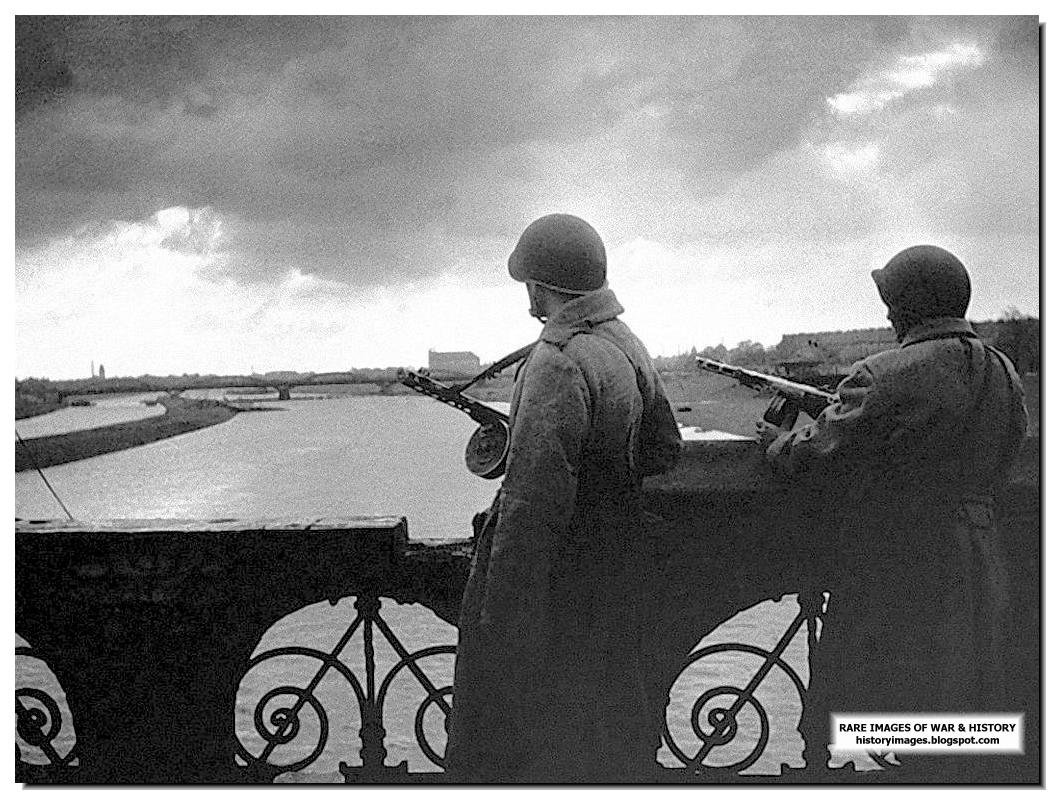The Battle of Breslau, also known as the Siege of Breslau, was a three month long siege of the city of Breslau in Lower Silesia, Germany (now Wrocław, Poland), lasting to the end of World War II in Europe. From 13 February-6 May 1945, German troops in Breslau were besieged by the Soviet forces which encircled the city as part of the Lower Silesian Offensive Operation. The German garrison's surrender on 6 May was followed the next day by the surrender of all German forces.
VIDEO: GERMAN NEWSREEL BRESLAU MARCH 1945
Russian soldiers engaged in street fighting. Glogau (Glogow) April 1945. The town was made into a stronghold by the Nazi government in 1945 during World War II. Glogau was besieged for six weeks by the Soviet Red Army and was 95% destroyed in the ensuing fighting. The Russian carries a German MP 40 machine gun, which was standard issue to SS soldiers
German civilians trudge back home A Russian sign-board on the Polish-German border. 1945 A T-34 tank trundles on the street of a German villageA SU 76 crew. The SU-76 (Samokhodnaya Ustanovka 76) was a Soviet self-propelled gun used during and after World War II.
The legend. General Konev (left) of the Ist Ukrainian Front. He and Zhukov were the two top Russian general who led the assault onto Germany in the dying moments of the war. Along with Konev is General Lelyushenko, commander of the 4th Tank Army. They are at the Poland-German border, Neisse area. April 1945 Lower Silesia. March 1945. Germans march along with Panther tanks March 1, 1945. Dead German soldiers lie alongside a King Tiger tank. Pomerania.HISTORY SIDESHOW: POMERANIA
Following the empire's defeat in World War I, Pomerelia was transformed into the Polish Corridor and the Free City of Danzig. Germany's Province of Pomerania was expanded in 1938 to include northern parts of the former Province of Posen–West Prussia, and in 1939 the annexed Polish Corridor became part of the wartime Reichsgau Danzig-West Prussia. The Nazis deported the Pomeranian Jews to a reservation near Lublinand, in Pomerelia, mass murdered Jews, as well as Poles to some extent, through Nazi Germany's anti-semitic and untermensch pogroms.
After Nazi Germany's defeat in World War II, the German–Polish border was shifted west to the Oder–Neisse line and all of Pomerania was under Soviet military control.The German population of the areas east of the line was expelled, and the area was resettled primarily with Poles (some themselves expellees from former eastern Poland) and some Ukrainians (resettled under Operation Vistula) and Jews. Most of Western Pomerania (Vorpommern) remained in Germany and today forms the eastern part of the state of Mecklenburg-Vorpommern, while the Polish part of the region is divided between the West Pomeranian and Pomeranian voivodeships, with their capitals in Szczecin (Stettin) and Gdańsk (Danzig), respectively.
Preparing to attack Berlin. Russian soldiers build a pontoon bridge on the river Oder. 1945
A German Heavy half-track tractor tows a Sd.Kfz.7 88-mm anti-aircraft gun FlaK on a city street of Stettin. March 1945
INTERESTING HISTORY SIDELIGHTS: STETTIN; THE CITY GERMANY LOST....
Source:
Yahoo AnswersStettin belonged to Germany until 1945 as a part of the state of Prussia, province of Pommern. After WW II the German territories eastern the Oder-Neisse line were given under Polish administration. Notwithstanding Stettin is located western of the Oder-River it was given to Polish administration too, to give to Poland the whole of the Oder-mouth into Baltic Sea. The Polish drove away the Germans from their homes and settled Polish population there as they did in the other German territories eastern of the Oder river. So it is now a Polish town: Sczezin. By treaty along with German reunification 1990 Germany had to acknowledge its territorial losses to Poland.
The whole thing has to do with the western shift of Poland by Roosevelt, Stalin and Churchill, to leave to Russia the eastern territories of Poland (which in reality were Belorussian and Litowian)which they had got by the Hitler-Stalin-Treaty 1939 and to compensate Poland with German territories. For decades there had been disagreement between the Federal Republic of Germany (Western Germany) as to the "temporary" state of Polish administration of German territories, which Poland had always claimed as definitive.
Hell on Earth. German civilians flee Danzig as it burns...March 1945German soldiers in an armored personnel carrier patrol the outskirts of a town in Germany. March 1945
Roadside signboard in Russian in Germany. Spring 1945 The soldiers of a Soviet assault battalion in combat in the ruins of the tram depot in Breslau. March 1945
The soldiers of the Waffen SS look at a destroyed Soviet tank T-34-85. in the German city of Guben. February 1945.
German defenders discuss how to defend Pirits in Pomerania. February 1945. Many of them are boys.
Germans walk past a Russian T-34-85 tank. Pomerania. February, 1945Young German soldiers walk down the street in the town of Lauban in Silesia. March 30, 1945.A Russian gun fires in Danzig. 1945The Russians prepare to move to Berlin
A German soldier armed with a Faustpatrone going to the front. Still cheerful! Brave man!
WHAT WAS A FAUSTPATRONE?
A forerunner of the Panzerfaust was the Faustpatrone (literally 'fist cartridge').
Much smaller in physical appearance, the Faustpatrone was actually heavier than the better-known Panzerfaust. Development of the Faustpatrone started in the summer of 1942 at the German company HASAG with the development of a smaller prototype called Gretchen ("little Gretel") by a team headed by Dr. Heinrich Langweiler in Leipzig. The basic concept was that of a recoilless gun; neither the Faustpatrone, nor its successor the Panzerfaust were rockets.
The IS 2 tank in eastern Pomerania. March 1945The Iosif Vissarionovich tank (or IS tank, also known as the Joseph Stalin tank), was a heavy tank developed by the Soviet Union during World War II and first used in the Kursk area in September 1943. The tanks in the series are also sometimes called JS.
The heavy tank was designed with thick armour to counter the German 88 mm guns, and carried a main gun that was capable of defeating the German Tiger and Panther tanks. It was mainly a breakthrough tank, firing a heavy high-explosive shell that was useful against entrenchments and bunkers. The IS-2 was put into service in April 1944, and was used as a spearhead in the Battle of Berlin by the Red Army in the final stage of the war.
The Russian air force dominated the skies totally. Luftwaffe was finished. Here Soviet planes fly over Germany.
Russian troops of the 2nd Belorussian Front occupy Mühlhausen (now the Polish city Mlynary)A Russian soldier fires from a tank at Germans at Danzig. March 28, 1945A German town. German soldiers surrender to Soviet troopsThe final destination. Russian soldiers look across the river Oder towards Berlin. March 1945 A short reversal of fortune. Russian soldiers of 311th Rifle Division in the German city Altdam, captured after heavy fighting during March 14-20, 1945.Russians pose at Muhlhausen
Russian soldiers move rapidly towards Berlin in armored troop carriers
A German soldier hanged in Koenigsberg. February 1945 for looting. The board says "those who loot will be executed".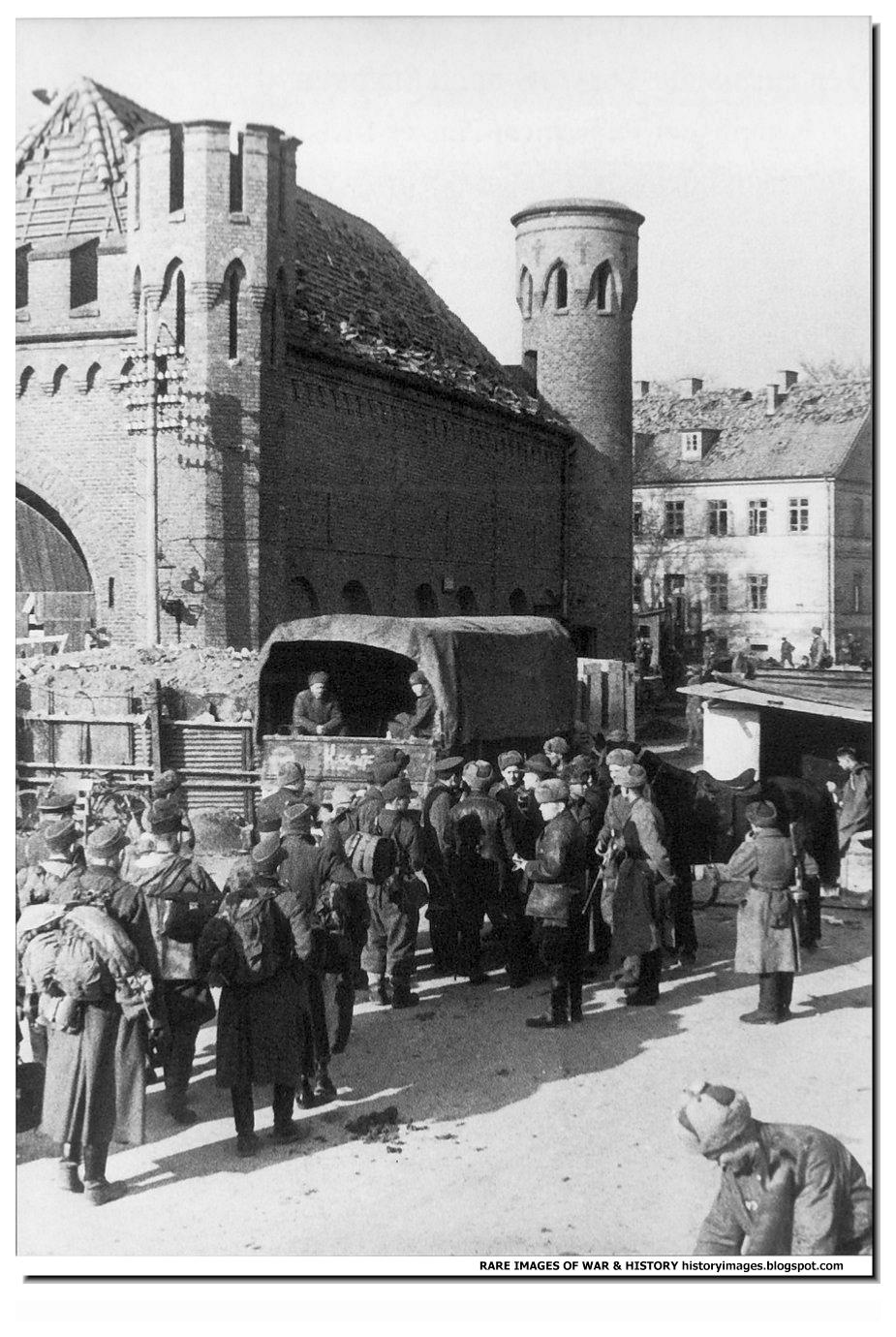 |
| German POW in Koenigsberg. April 1945 |
As the russians approached Germany the German civilians fled from East Prussia. Here German refugees get aboard the Hans Albrecht Wedel, the air traffic control ship of the Luftwaffe at Pillau. February 1945
MORE ON PILLAU
As the Red Army entered East Prussia, more than 450,000 refugees were ferried from Pillau to central and western Germany. Pillau was eventually captured by Soviets on April 25, 1945. After the war, this part of East Prussia passed to the Soviet Union, and the German inhabitants were expelled. During the Russification campaign, the town's name was changed to
Baltiysk in 1946.
The German 88mm artillery waits for the inevitable Russian onslaught. East Prussia. February 1945The capitulation of the Germans in the spit-Frisch Nerung. 1945.
FRISCH NERUNG
The Vistula Spit (German
Die Frische Nehrung, Polish
Mierzeja Wiślana , Russian
Балтийская коса Baltiyskaya Kosa ) is a narrow spit of land ( spit ) of about 70 km long and several hundred meters in width (maximum width 1.8 km), extending in a northeasterly direction and the Vistula Lagoon of the open Baltic Sea separates. Across the Vistula Spit is the boundary between Poland ( Pomeranian Voivodeship ) and Russia ( Kaliningrad Oblast ).
At the end of the Second World War was over the frozen lagoon and the Vistula Spit one of the main route of refugees from East Prussia to the west.
Waiting for the Russians with little hope. German defensive positions on the outskirts of Konigsberg.German landing craft, evacuating troops , enters the harbor of Pillau, March 1945.Belonging to the 5th Armored Division tank Pz.Kpfw. V Ausf. G «Panther" on the street of Goldap. East Prussia, in November 1944.
MORE ON GOLDAP
During World War II Goldap was planned by the German staff as one of the strongholds guarding the rest of East Prussia from the Red Army on the Eastern Front. As a result of heavy fighting for the city and the regions directly east of it, in August and September 1944, 90% of the town was yet again destroyed. According to German war-time reports, about 50 civilians were murdered (some raped) by the Red Army on its initial entry into Goldap in October 1944. It was the first town of the German Reich to fall. However, in November 1944 the Wehrmacht reconquered Goldap and would be able to keep it until the end of December of the same year. In January, the German positions in far-eastern East Prussia broke down completely.
German sentry on the bridge in the center of Konigsberg. February 1945.Parts of the German 5th Army waits. in tanks "Panther" and APCs in the district of Kattenau, East Prussia, 14 January 1945.The Russian army managed to subdue the German forces at Pillau only on April 25, 1945
War at Goldap. German soldiers fire at Russian position at Goldap railway station. November 1944.
VIDEO
WW2 footage. German Wartime Newsreel (Die Deutsche Wochenschau Nr. 741, 16-Nov-1944) The Gumbinnen Operation, also known as the Goldap Operation (or Goldap-Gumbinnen Operation), was a Soviet offensive on the Eastern Front late in 1944, in which forces of the 3rd Belorussian Front attempted to penetrate the borders of East Prussia. The offensive failed, due to strong resistance by the Wehrmacht. As a result it is largely known through German accounts of the defence and because of the atrocities that were alleged to have been committed by troops of the 11th Guards Army, the so-called Nemmersdorf massacre. On 16 October, the 5th and 11th Guards Armies went onto the offensive and initially penetrated some 11 km into the German defensive belt. The flanking armies commenced operations the next day, by which time units of the 11th Guards Army had crossed the East Prussian border. The Soviet troops ran into extremely strong resistance, however. It took them four days to penetrate the initial tactical defences, while the second defence line was so strong that Chernyakhovsky was compelled to commit the 2nd Guards Tank Corps to break it. Casualties were extremely heavy. On 20 October, the second line was ruptured by the 11th Guards Army and 2nd Guards Tank Corps east of Gumbinnen, defended by the guns of the 18th Anti-Aircraft Division and the Fallschirm-Panzerkorps Hermann Göring, which had been redeployed in the area to counter the Soviet advance.
German soldiers drop their arms before being evacuated from Pillau. April 1945Germans at Goldap. November 1944
The Nemmersdorf Massacre. A trailer of the rape and atrocities that the appraoching Russian army would commit in Germany.
THE NEMMERSDORF MASSACRE: BRUTAL RUSSIANS
Nemmersdorf in East Prussia (today's Mayakovskoye, Kaliningrad Oblast) was one of the first pre-war ethnic German villages to fall to the advancing Red Army in World War 2. On October 22, 1944 it was the scene of a massacre perpetrated by the Soviet soldiers against German civilians and French and Belgian noncombattants. Determining the facts has aroused controversy. Scholars now generally believe that while the massacre occurred the Nazi Propaganda Ministry embellished the incident for propaganda purposes.
The 2nd Battalion, 25th Guards Tank Brigade, belonging to the 2nd Guards Tank Corps of the 11th Guards Army, crossed the Angrapa bridge and established a bridgehead on the western bank of the river. German forces tried to retake the bridge, but several attacks were repelled by the Soviet tanks and the supporting infantry. During an air attack, a number of Soviet soldiers took shelter in an improvised bunker already occupied by 14 local men and women.
According to the testimony of the seriously injured Gerda Meczulat, when a Soviet officer arrived and ordered everybody out, the Russians shot and killed the German civilians at close range. During the night, the Soviet 25th Tank Brigade was ordered to retreat back across the river and take defensive positions along the Rominte. The Wehrmacht regained control of Nemmersdorf and discovered the massacre.
German authorities organized an international commission to investigate, headed by Estonian Hjalmar Mäe and other representatives of neutral countries, such as Spain, Sweden and Switzerland. The commission heard the report from a medical commission. It reported that all the dead women had been raped (they ranged in age from eight to 84). The Nazi Propaganda Ministry,(separately) used the Völkischer Beobachter and the cinema Wochenschau) to accuse the Soviet Army of having killed tens of civilians at Nemmersdorf and summarily executed about 50 French and Belgian noncombatant POWs,that had been ordered to take care of thoroughbred horses, but had been blocked by the bridge. The civilians were allegedly killed by blows with shovels or gun butts. Karl Potrek of Königsberg, leader of a Volkssturm company present on the retaking of the village, testified in a 1953 report:
"In the farmyard stood a cart, to which more naked women were nailed through their hands in a cruciform position...Near a large inn, the 'Roter Krug', stood a barn and to each of its two doors a naked woman was nailed through the hands, in a crucified posture....In the dwellings we found a total of 72 women, including children, and one old man, 74, all dead....Some babies had their heads bashed in."
The former chief of staff of the German Fourth Army, Major General Erich Dethleffsen, testified on July 5, 1946 before an American tribunal in Neu-Ulm. He said:
"When in October, 1944, Russian units temporarily entered Nemmersdorf, they tortured the civilians, specifically they nailed them to barn doors, and then shot them. A large number of women were raped and then shot. During this massacre, the Russian soldiers also shot some fifty French prisoners of war. Within forty-eight hours the Germans re-occupied the area
The Nazi Propaganda Ministry disseminated a graphic description of the events with the intention to inspire the German soldiers. On the home front, civilians reacted immediately, with an increase in the number of volunteers joining the Volkssturm.A larger number of civilians responded with panic, and started to leave the area en masse.
To many Germans, "Nemmersdorf" is a symbol of war crimes committed by the Red Army, and an example of the worst behavior in Eastern Germany. Marion Gräfin Dönhoff, the post-war co-publisher of the weekly Die Zeit, at the time of the reports lived in the village of Quittainen (Kwitany) in western East Prussia, near Preussisch Holland (Pasłęk). She wrote in 1962 that: "In those years one was so accustomed to everything that was officially published or reported being lies that at first I took the pictures from Nemmersdorf to be falsified. Later, however, it turned out that that was not the case."
Most historians now generally believe that the fact that a massacre by Soviet forces is beyond reasonable dispute, although the accounts by the German Propaganda Ministry embellished the massacre for propaganda purposes.
Germans surrender in East Prussia












































